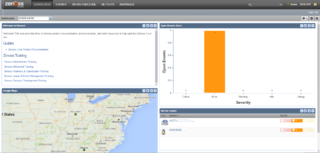
Computer operating systems (OSes) provide a set of functions needed and used by most application programs on a computer, and the links needed to control and synchronize computer hardware. On the first computers, with no operating system, every program needed the full hardware specification to run correctly and perform standard tasks, and its own drivers for peripheral devices like printers and punched paper card readers. The growing complexity of hardware and application programs eventually made operating systems a necessity for everyday use.

General Comprehensive Operating System is a family of operating systems oriented toward the 36-bit GE-600 series and Honeywell 6000 series mainframe computers.

CUPS is a modular printing system for Unix-like computer operating systems which allows a computer to act as a print server. A computer running CUPS is a host that can accept print jobs from client computers, process them, and send them to the appropriate printer.
The Pick Operating System, also known as the Pick System or simply Pick, is a demand-paged, multi-user, virtual memory, time-sharing computer operating system based around a MultiValue database. Pick is used primarily for business data processing. It is named after one of its developers, Dick Pick.
An energy management system (EMS) is a system of computer-aided tools used by operators of electric utility grids to monitor, control, and optimize the performance of the generation or transmission system. Also, it can be used in small scale systems like microgrids.
A dedicated hosting service, dedicated server, or managed hosting service is a type of Internet hosting in which the client leases an entire server not shared with anyone else. This is more flexible than shared hosting, as organizations have full control over the server(s), including choice of operating system, hardware, etc.
A job scheduler is a computer application for controlling unattended background program execution of jobs. This is commonly called batch scheduling, as execution of non-interactive jobs is often called batch processing, though traditional job and batch are distinguished and contrasted; see that page for details. Other synonyms include batch system, distributed resource management system (DRMS), distributed resource manager (DRM), and, commonly today, workload automation (WLA). The data structure of jobs to run is known as the job queue.
A transaction processing system (TPS) is a software system, or software/hardware combination, that supports transaction processing.
Open iT, Inc. is an independent software vendor that specializes in metering, analyzing, and optimizing usage of critical IT assets. It was founded in 1999 by Eistein Fosli, who obtained his Master of Science in Information Technology from the University of Oslo.

The company Zenoss, Inc. was founded in 2005 and is headquartered in Austin, Texas. The company develops hybrid IT monitoring and analytics software.
Configurable Network Computing or CNC is JD Edwards's (JDE) client–server proprietary architecture and methodology. Now a division of the Oracle Corporation, Oracle continues to sponsor the ongoing development of the JD Edwards Enterprise Resource Planning (ERP) system, While highly flexible, the CNC architecture is proprietary and, as such, it cannot be exported to any other systems. While the CNC architecture's chief 'Claim to fame', insulation of applications from the underlying database and operating systems, were largely superseded by modern web-based technology, nevertheless CNC technology continues to be at the heart of both JD Edwards' One World and Enterprise One architecture and is planned to play a significant role Oracle's developing fusion architecture initiative. While a proprietary architecture, CNC is neither an Oracle nor JDE product offering. The term CNC also refers to the systems analysts who install, maintain, manage and enhance this architecture. CNC's are also one of the three technical areas in the JD Edwards Enterprise Resource Planning ERP which include developer/report writer and functional/business analysts.
Vinzant Software is a privately held company headquartered in Hobart, Indiana. Established in 1988 by David Vinzant, the company specializes in developing and marketing enterprise job scheduling software for various platforms including Windows, Unix, Linux, IBM i, and MPE/ix.
Production support covers the practices and disciplines of supporting the IT systems/applications which are currently being used by the end users. A production support person/team is responsible for monitoring the production servers, scheduled jobs, incident management and receiving incidents and requests from end-users, analyzing these and either responding to the end user with a solution or escalating it to the other IT teams. These teams may include developers, system engineers and database administrators.
The Softwell Maker is an environment development. Designer uses visual forms and reports (WYSIWYG), business rules, and visually representing other actions using flowcharts.
OS 2200 is the operating system for the Unisys ClearPath Dorado family of mainframe systems. The operating system kernel of OS 2200 is a lineal descendant of Exec 8 for the UNIVAC 1108 and was previously known as OS 1100. Documentation and other information on current and past Unisys systems can be found on the Unisys public support website.
Techila Distributed Computing Engine is a commercial grid computing software product. It speeds up simulation, analysis and other computational applications by enabling scalability across the IT resources in user's on-premises data center and in the user's own cloud account. Techila Distributed Computing Engine is developed and licensed by Techila Technologies Ltd, a privately held company headquartered in Tampere, Finland. The product is also available as an on-demand solution in Google Cloud Launcher, the online marketplace created and operated by Google. According to IDC, the solution enables organizations to create HPC infrastructure without the major capital investments and operating expenses required by new HPC hardware.
The Universal Time-Sharing System (UTS) is a discontinued operating system for the XDS Sigma series of computers, succeeding Batch Processing Monitor (BPM)/Batch Time-Sharing Monitor (BTM). UTS was announced in 1966, but because of delays did not actually ship until 1971. It was designed to provide multi-programming services for online (interactive) user programs in addition to batch-mode production jobs, symbiont (spooled) I/O, and critical real-time processes. System daemons, called "ghost jobs" were used to run monitor code in user space. The final release, D00, shipped in January, 1973. It was succeeded by the CP-V operating system, which combined UTS with features of the heavily batch-oriented Xerox Operating System (XOS).

GroupWise is a messaging and collaboration platform from OpenText that supports email, calendaring, personal information management, instant messaging, and document management. The GroupWise platform consists of desktop client software, which is available for Windows,, and the server software, which is supported on Windows Server and Linux.

MSP360, formerly CloudBerry Lab, is a software and application service provider company that develops online backup, remote desktop and file management products integrated with more than 20 cloud storage providers.




